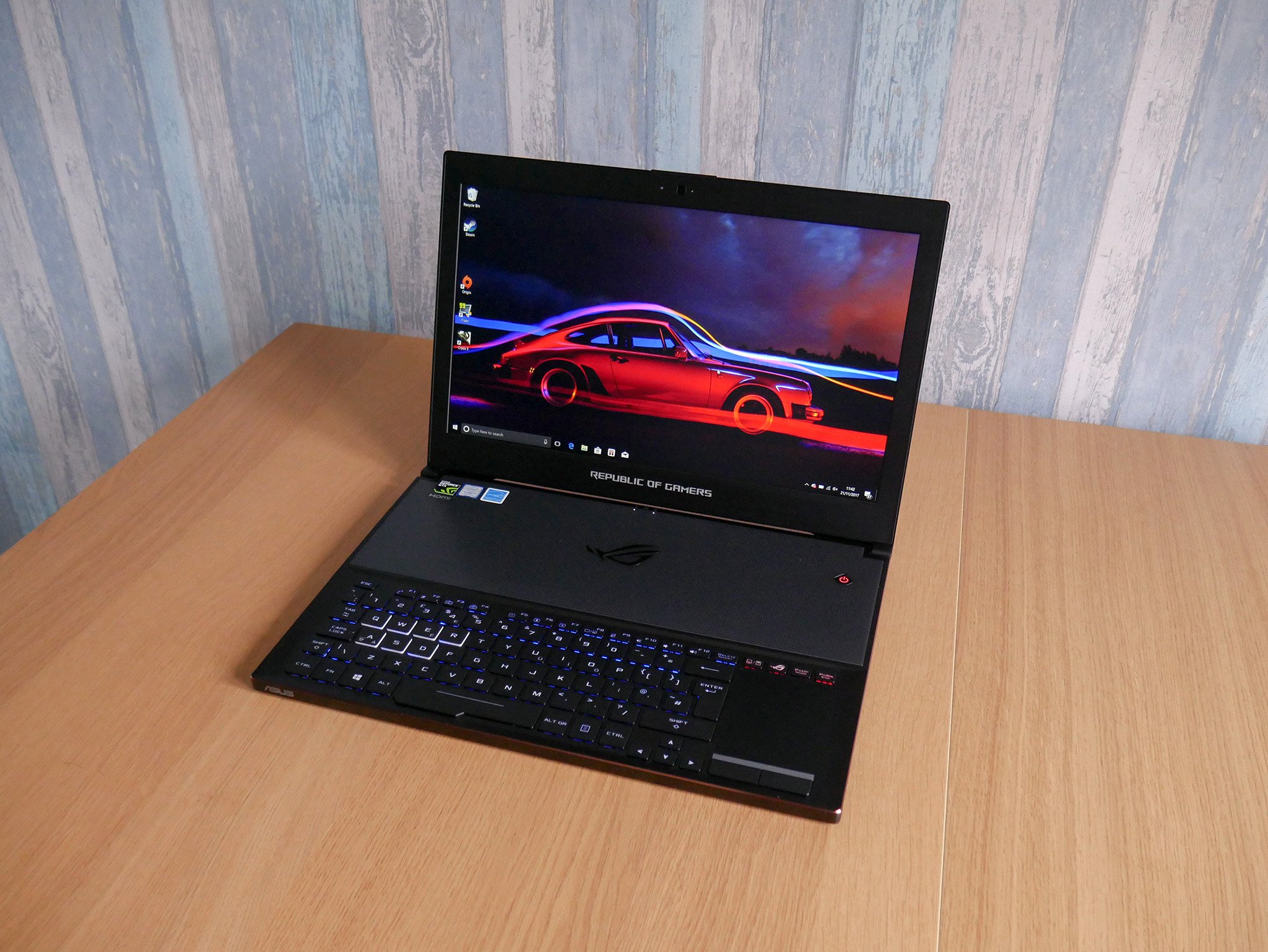
This isn't the first gaming laptop to have an NVIDIA GTX 1080 inside for supreme gaming performance on the go. But it's also no ordinary GTX 1080. The Zephyrus is the poster child for NVIDIA's new MaxQ technology, designed to help squeeze ridiculous performance into ever slimmer form factors.
Compared to most "normal" high-end gaming laptops, this is slim and light and incredibly portable. It is the laptop equivalent of a high-powered sports car.
About this review
Our review was conducted using a review unit provided by ASUS UK to Windows Central. The specs are detailed below. Throughout the course of the review, the laptop was running on the latest public release of Windows 10 and the latest NVIDIA drivers with G-Sync enabled. The retail price is $2,699.
ASUS ROG Zephyrus tech specs
| Category | Specification |
|---|---|
| Processor | Intel Core i7-7700HQ Quad Core |
| Display | 15.6-inch 1080p with G-Sync120Hz refresh rate |
| Storage | 512GB SSD |
| RAM | 16GB dual-channel DDR4 2400MHz |
| GPU | NVIDIA GeForce GTX 1080 with MaxQ8GB of GDDR5 VRAM |
| OS | Windows 10 Home 64-bit |
| Networking | Integrated 802.11 AC (2x2), 10/100/1000 Base TBluetooth 4.1 |
| Ports | Thunderbolt 3 USB-C, four USB 3.0, HDMI 2.0 |
| Audio | Built-in Stereo 2W SpeakersArray microphone |
| Webcam | HD |
| Battery | 50Wh lithium-iron polymer battery |
| Weight | 2.25kg |
| Dimensions | 37.9 cm x 26.2 cm x 1.79 cm (W x D x H) |
The model we have in for review is the top spec version with a 512GB Samsung NVMe solid-state drive (SSD) and GTX 1080 with MaxQ design. There is a less expensive model available with a 256GB SSD and a GTX 1070 that costs $1,999.
ASUS ROG Zephyrus hardware and design
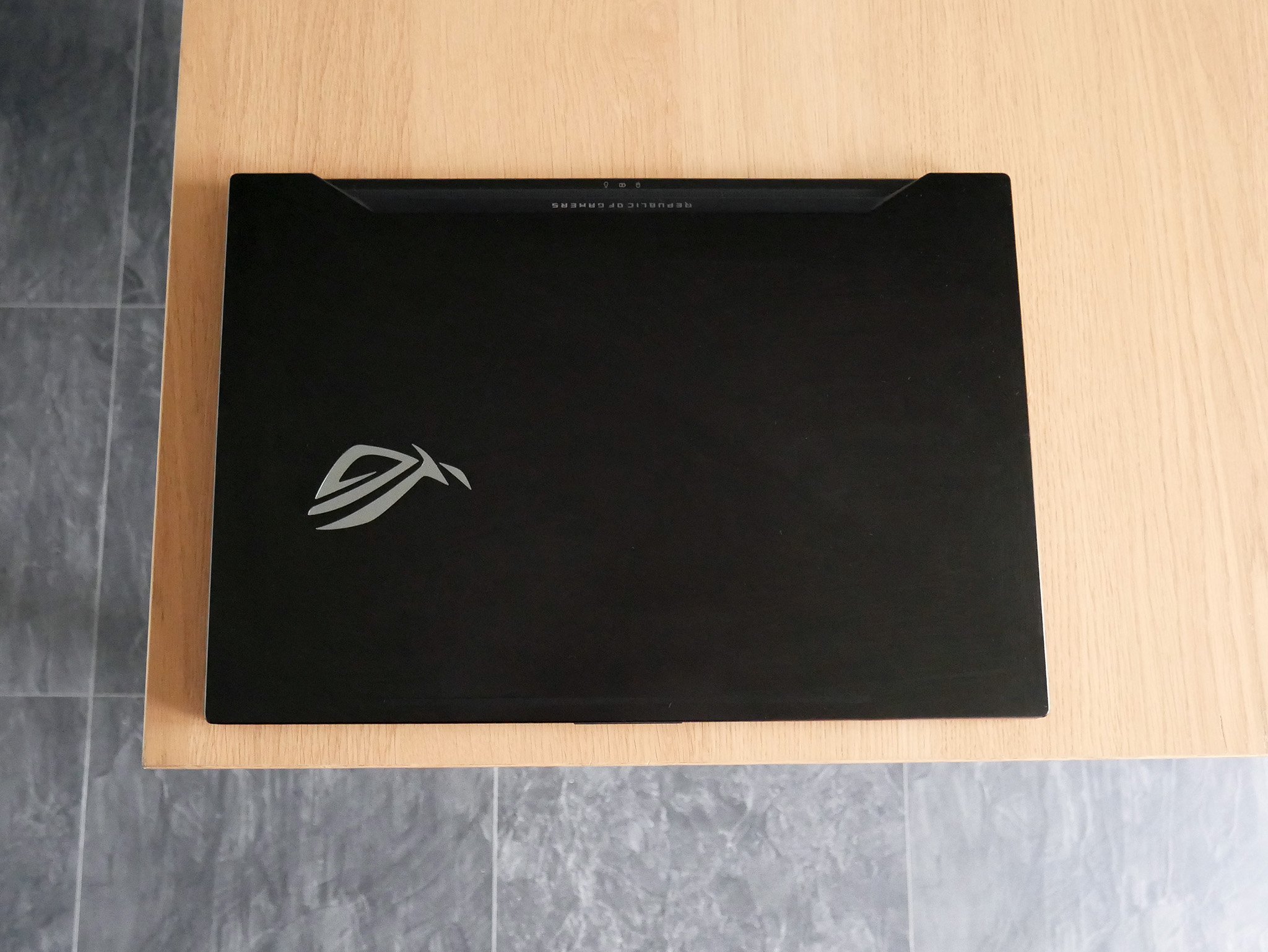
ASUS has been known to go a little mad when designing gaming laptops (we all remember the gargantuan G752). Things have toned down in recent times, and the Zephyrus is its best-looking to date. When closed, it's an all-black metallic affair with brushed effects on the lid, that stealthy monotony broken only by copper chamfers and exhaust vents on the rear. When open, the company logo on the lid lights up.
There are no tapers here, the laptop is the same thickness right through. And while it's no Ultrabook, you can hardly call it thick. It's easily small enough to fit into a normal laptop bag for 15-inch laptops and doesn't weigh that much. It certainly doesn't feel any more cumbersome than those 15-inch MacBook Pros people lug around.
The outside is understated but stylish, and then you open the lid and things are quite different. ASUS didn't just move the keyboard forward to make it stand out, all of the good stuff inside that makes the gaming magic happens is beneath the ROG logo, and as such, it's where you'd normally find the keyboard. To relieve some of the discomforts of typing when there is nowhere to put your wrists, ASUS includes a wrist rest in the box with the laptop.
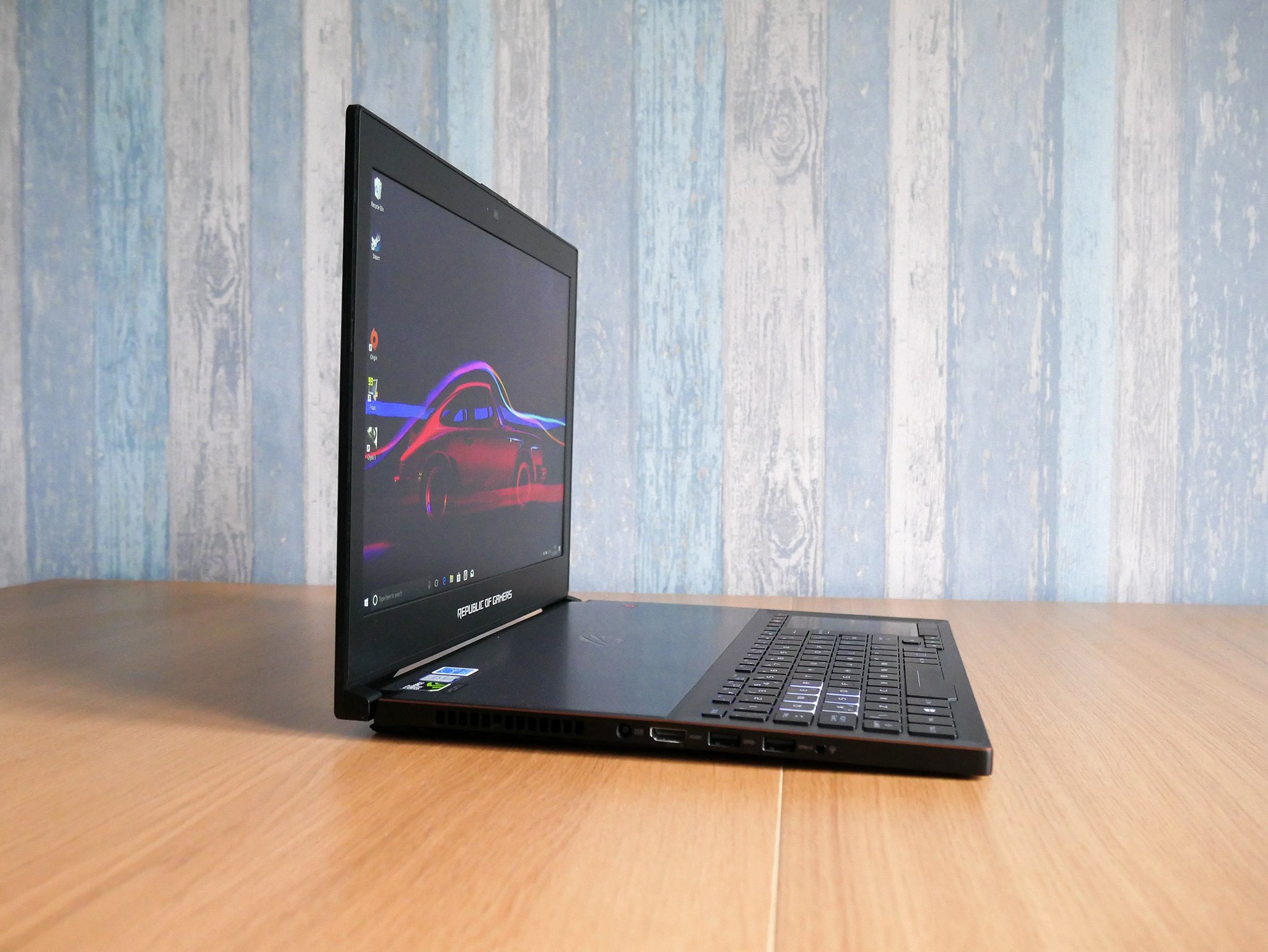
It's not particularly ideal if you travel a lot and use the Zephyrus for more than just gaming, since it's something else to pack, but it's one of those thoughtful touches that show ASUS properly considered customer experience.
Another unique aspect of the design is how it lifts up underneath when you open the lid, providing a nice gap beneath for air to flow. This area also lights up red, just to draw attention to it, though if you're using it on your lap it flexes quite a bit. It's a clever design touch to help cool the laptop down.
Inside, nothing is missing. There's a MaxQ 8GB GTX 1080 GPU, a Core i7-7700HQ processor at 2.8GHz, 512GB NVMe SSD and 16GB of RAM. It's not quite Razer Blade Pro-scale, but it's pretty close. And a lot cheaper.
ASUS ROG Zephyrus keyboard and display
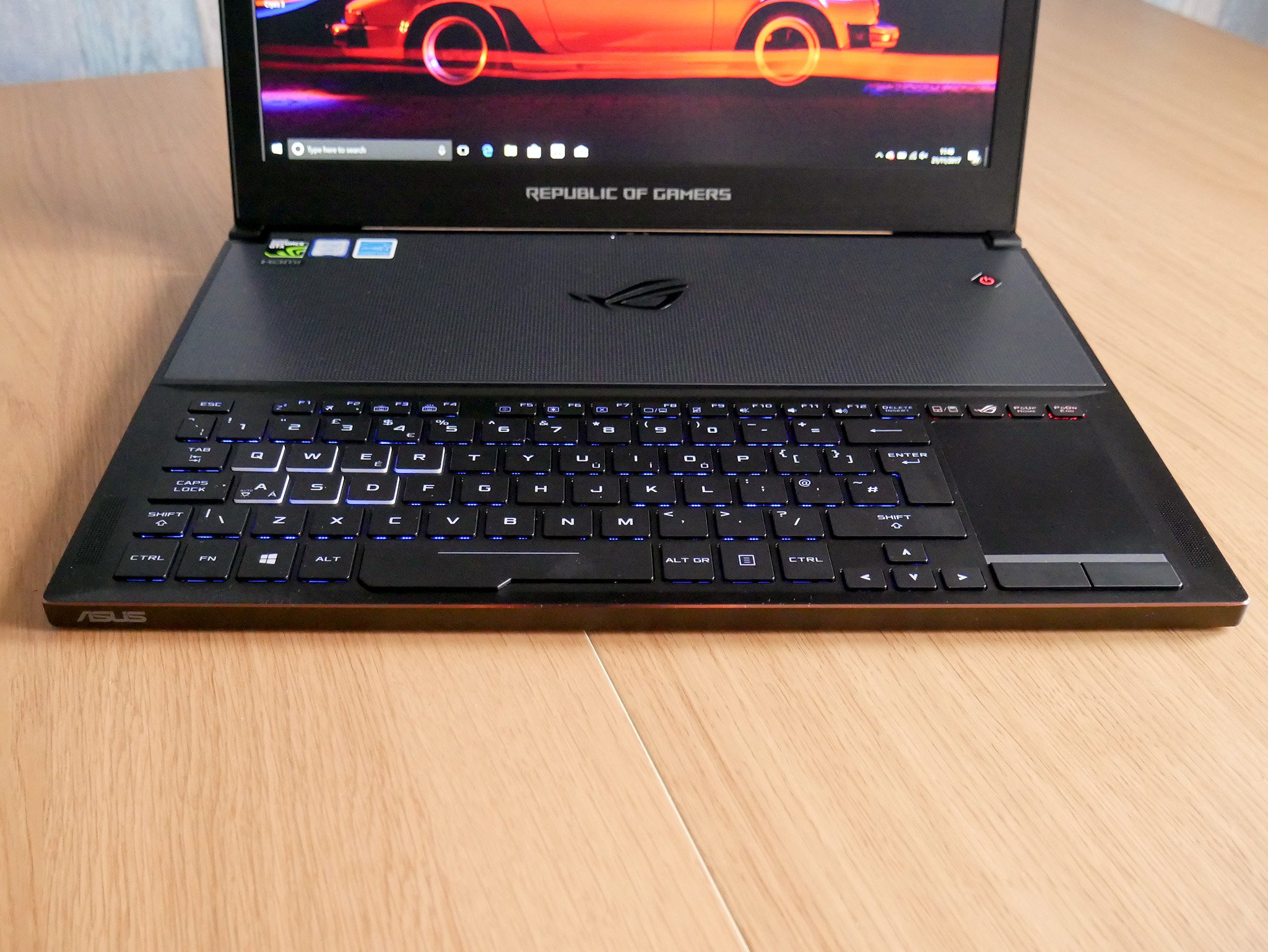
Since the keyboard is at the front, the trackpad has had to make way, and it's to be found on the right-hand side of the keyboard, a la the Razer Blade Pro. The positioning doesn't take much getting used to (if you're right-handed anyway) since it's basically where you'd move your hand on a mouse. It's actually really natural when you get over the initial muscle-memory issue.
What might be less comfortable is the size of it. The trackpad has been positioned so it's taller, not wider, but even then it's definitely smaller than you'd get on most laptops. Gamers won't be playing anything with it, so in that regard, it's not a dealbreaker, but if you enjoy a large trackpad you're out of luck. It uses Precision drivers, though; it's just on the small side. The best bit about the trackpad is that with a single button press it can transform into a number pad, so if you need it or you use a mouse all the time you can have a full keyboard layout.
The keyboard itself is fantastic. It's not mechanical, but it's not super low-profile, either, so there's quite a bit of key travel. In a pinch, it wouldn't be too bad to game with if you're out and about. For typing, it's grand.
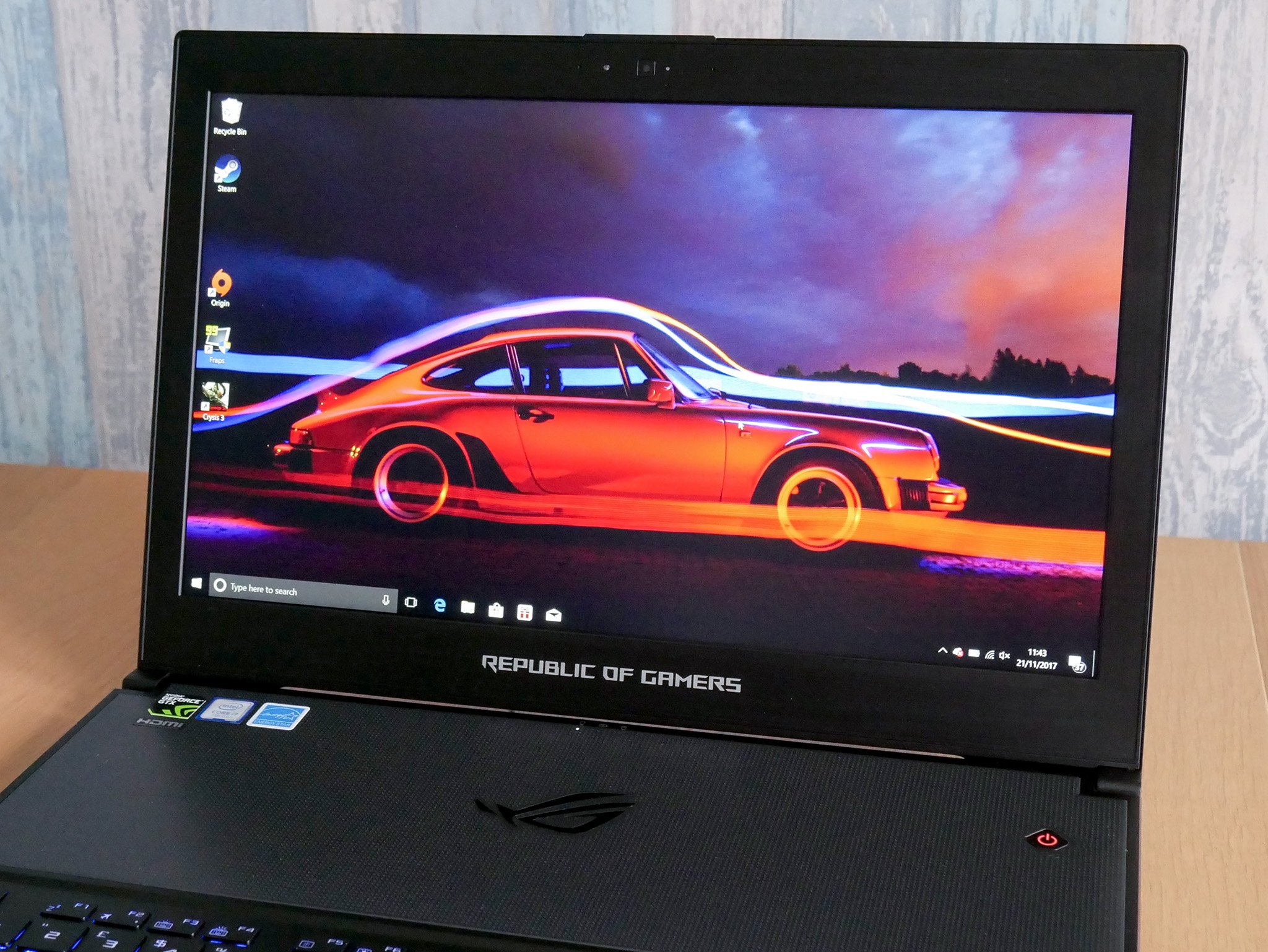
Given what's inside this laptop you may expect to find a 4K display in the lid, but you'd be wrong. Instead, you get a 120Hz 1080p display with NVIDIA G-Sync. Personally, I'd take 120Hz and G-Sync at this size over 4K at 60Hz without question. The lack of a 4K touch display also helps keep the price inside the stratosphere.
It's a really nice display, too, with a matte finish so there's no nasty glare interfering with your games. But it's the high-refresh rate and G-Sync that matter most here. With a GTX 1080 inside, you're pushing high frame rates on a display that can actually handle it.
ASUS has a built-in app that can change color profiles on the fly depending on which type of games you're playing, but personally, I think they all look terrible. I left it in the sRGB mode the whole time and wasn't disappointed.
ASUS ROG Zephyrus performance
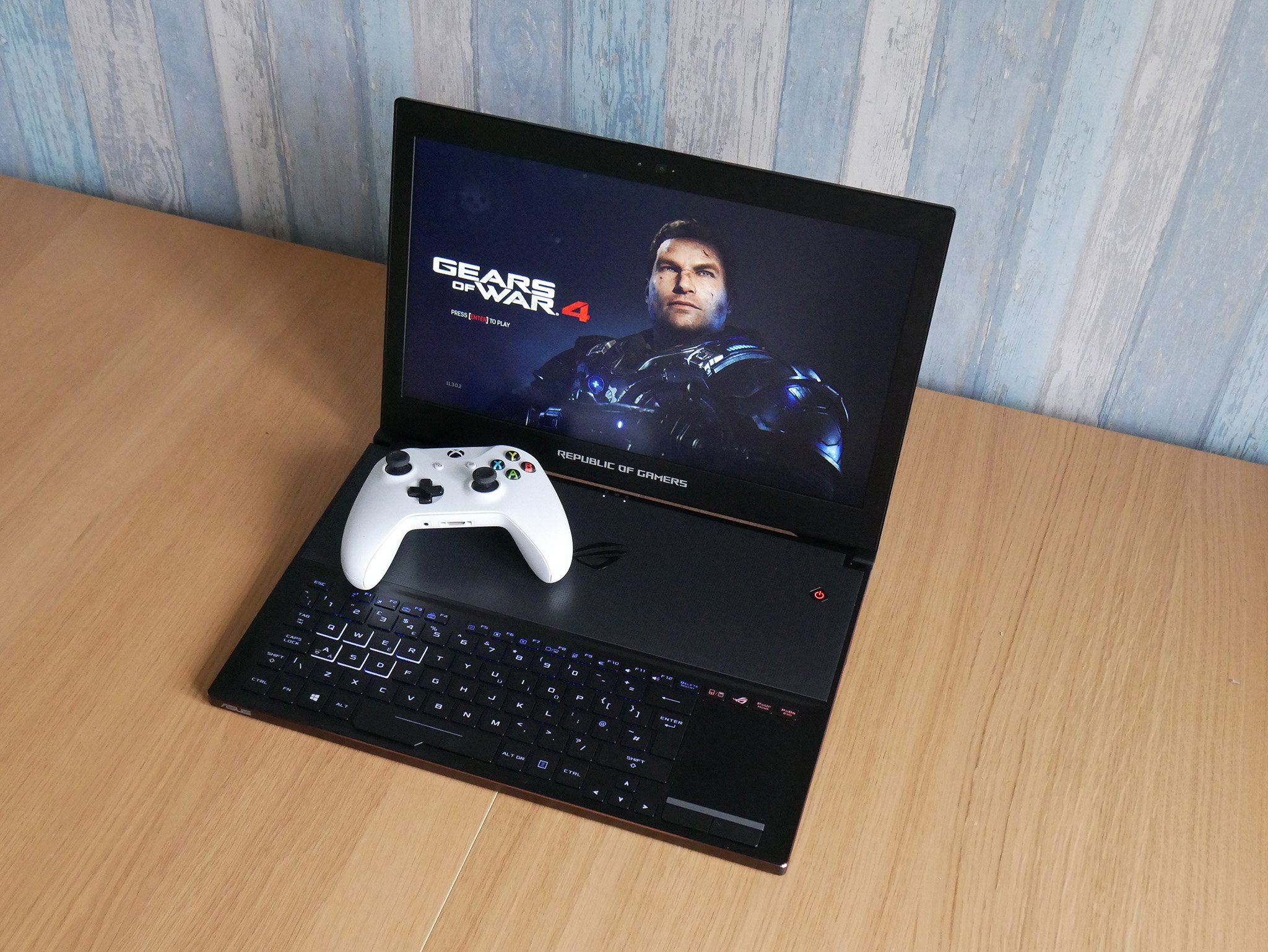
The interesting design makes this laptop stand out from the crowd, but it's not honestly why we're really interested in it. The Zephyrus was one of the first laptops announced to use NVIDIA MaxQ technology to squeeze a GTX 1080 inside a laptop that normally wouldn't stand a chance.
The added bonus is that if you're shelling out for one of these, it's powerful enough to be both an amazing laptop and a high-end gaming rg when hooked up to an external display.
So, with a Core i7-7700HQ and 16GB of RAM backing up that GTX 1080, as well as an NVMe SSD, we came into this expecting big things. Here's a look at the figures (click to see each section).
CPU
Geekbench 4 Benchmarks (Higher is better)
| Device | CPU | Single core | Multi core |
|---|---|---|---|
| ASUS ROG Zephyrus | i7-7700HQ | 4,322 | 13,213 |
| ASUS ZenBook Pro | i7-7700HQ | 4,021 | 13,270 |
| ASUS GR8 II | i5-7400 | 4,093 | 11,819 |
| Lenovo Legion Y720 | i7-7700HQ | 4,697 | 14,810 |
| Razer Blade Stealth | i7-7500U | 4,211 | 8,333 |
| Dell XPS 15 | i7-7700HQ | 4,503 | 13,587 |
| Surface Laptop | i7-7660U | 4,677 | 9,538 |
There are no surprises in CPU performance aside from a few mild variations compared to other laptops running the same CPU. It beats out a desktop quad-core Core i5 quite handily
GPU
Geekbench 4 Graphics OpenCL (Higher is better)
| Device | Score |
|---|---|
| ASUS ROG Zephyrus GTX 1080 MaxQ | 168,596 |
| ASUS ZenBook Pro GTX 1050 4GB | 65,444 |
| ASUS GR8 II GTX 1060 3GB | 126,311 |
| Razer Blade 14 GTX 1060 6GB | 139,603 |
| Surface Book GTX 965M | 63,029 |
| Surface Studio GTX 965M | 53,685 |
| ASUS Strix GL753 GTX 1050 | 76,007 |
Compared to past and present generation GPUs of various levels, the immense performance advantage the MaxQ GTX 1080 offers is clear.
Storage
CrystalDiskMark (Higher is better)
| Device | Read | Write |
|---|---|---|
| ASUS ROG Zephyrus | 2,380.1 MB/s | 1,284.1 MB/s |
| ASUS ZenBook Pro | 523.9 MB/s | 501.2 MB/s |
| Razer Blade (960 EVO) | 2,079 MB/s | 1809 MB/s |
| MacBook Pro 13 (2016) | 1,549 MB/s | 1,621 MB/s |
| Spectre x360 512 | 1,332 MB/s | 589 MB/s |
| XPS 13 (9360) 256 | 1,287 MB/s | 794 MB/s |
| Surface Book 1TB | 1,018 MB/s | 967 MB/s |
The Zephyrus has a 512GB Samsung NVMe SSD drive inside it and it is fast. In both sequential and 4K benchmarks in CrystalDiskMark, it performs exceptionally well.
We also used Futuremark's 3DMark benchmarking tools, putting the Zephyrus through the Fire Strike and Time Spy DX12 tests. In this case, specifically to see how it matches up to the Razer Blade Pro with a GTX 1080 from late 2016 (click to see each section).
3DMark (Fire Strike 1.1)
| Device | Score |
|---|---|
| ASUS ROG Zephyrus | 7,546 |
| Razer Blade Pro 1080 (2016) | 7,857 |
3DMark (Time Spy DX12)
| Device | Score |
|---|---|
| ASUS ROG Zephyrus | 5,551 |
| Razer Blade Pro 1080 (2016) | 5,591 |
The Blade Pro scored marginally higher, though the numbers we ran are from 2016 and the first version of the new Blade Pro. But, the Razer Blade Pro is the one to beat, and the Zephyrus comes very close to it.
When it comes to games, performance is very strong. For consistency, these were all run at their highest settings on the native 1080p resolution of the laptop's display. NVIDIA G-Sync was turned on.
- Gears of War 4: 113.7 frames per second (FPS) average.
- Rise of the Tomb Raider: 93.27 FPS average.
- GTA V: 113.7 FPS average.
- PlayerUnknown's Battlegrounds: 65 FPS average.
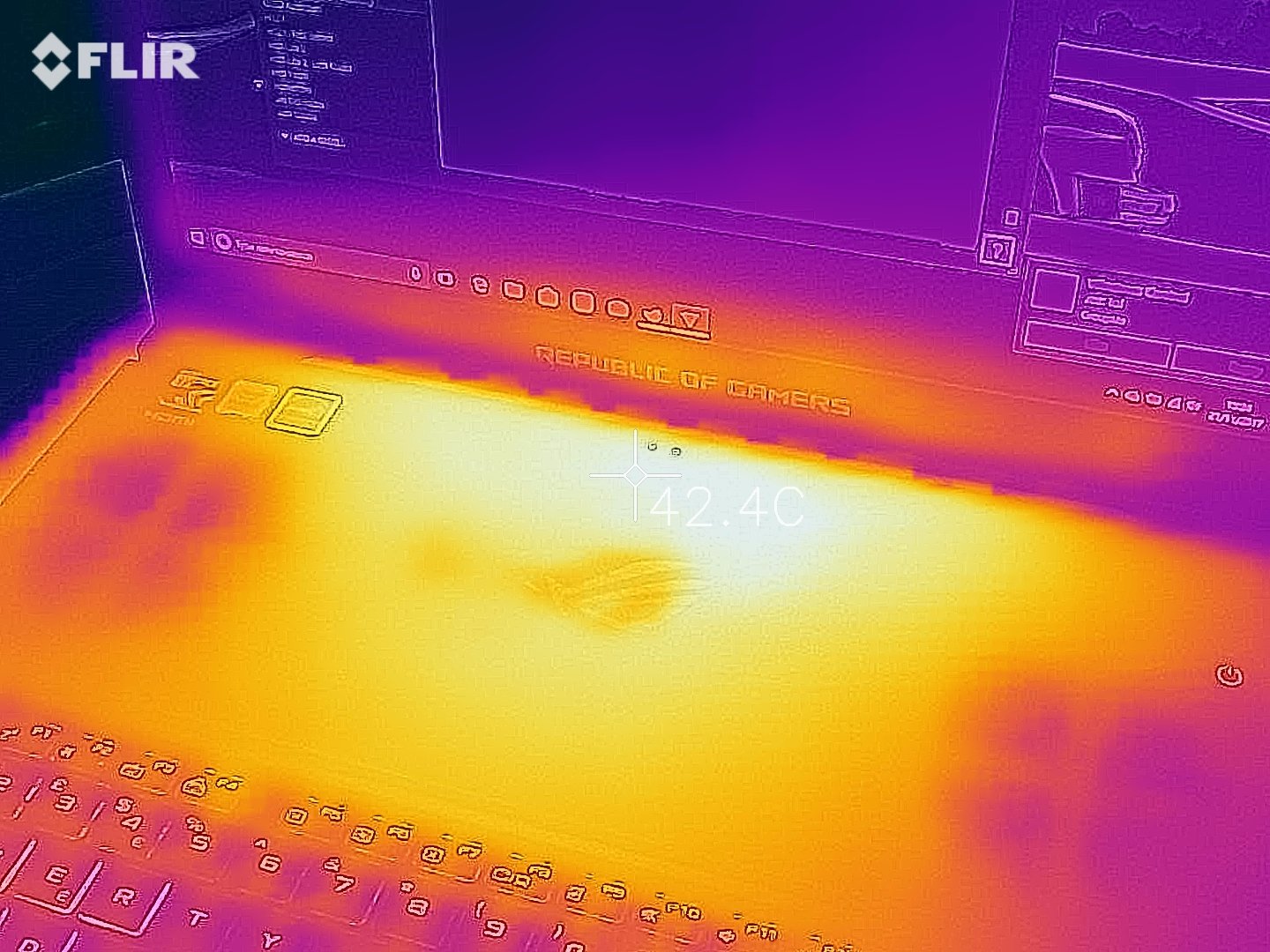
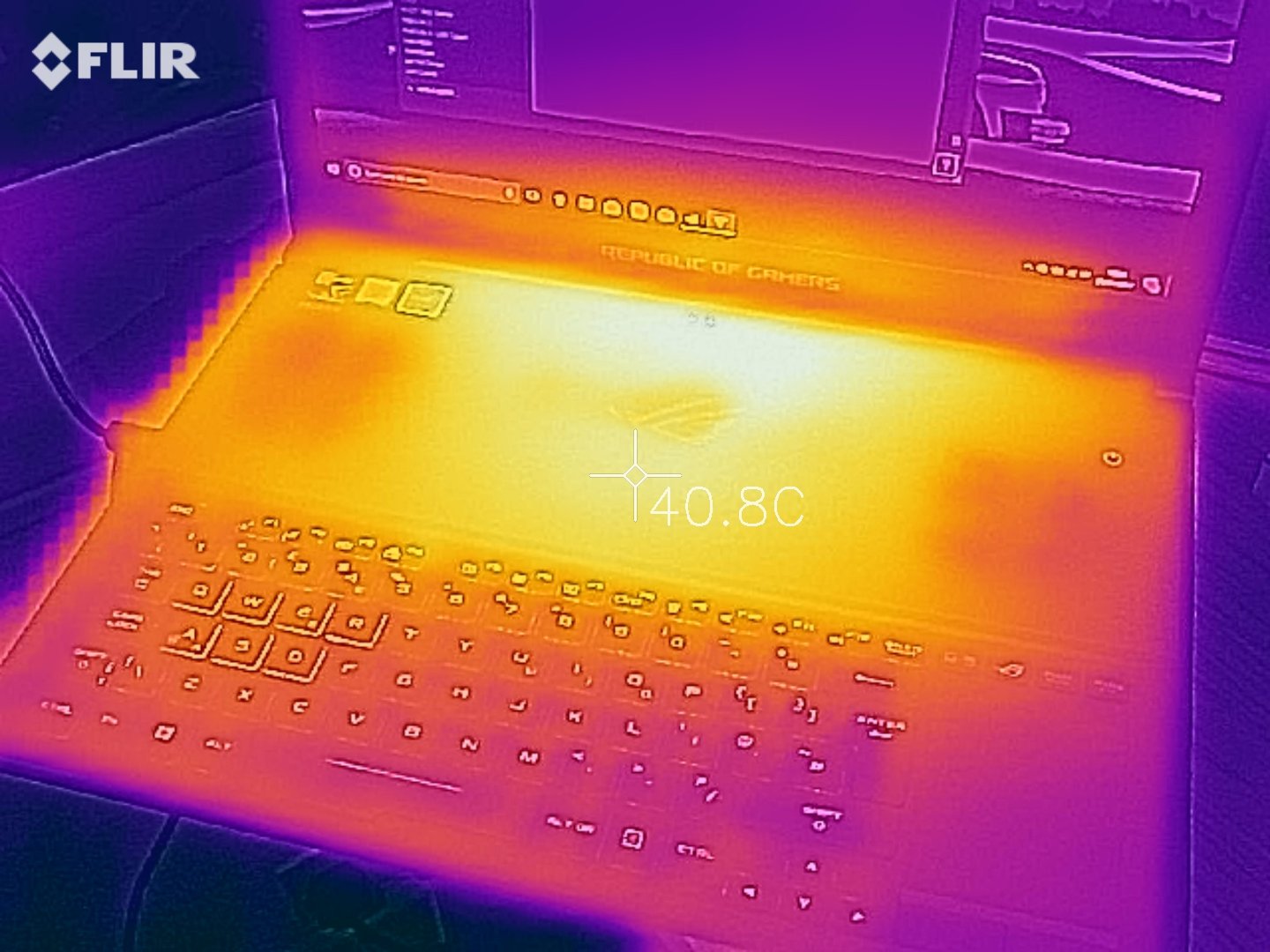
This laptop is clearly capable of delivering above 1080p gaming at high frame rates, but maxed out these games are all making the best of that 120Hz refresh rate.
Checking out how hot the Zephyrus gets when gaming, and it seems to top out at 42.4 degrees C (108.3 F), with the heat almost entirely centered around the ROG logo behind the keyboard and in line with the vents on the rear. As you can see from the second image, the heat doesn't dissipate much over the keyboard, and even at the hottest point, it's not burning to touch. There's a fair amount of fan noise, but nothing extraordinary.
The Zephyrus also easily meets the spec for Windows Mixed Reality Ultra, and with an HDMI output right next to a USB 3.0 port, connecting a headset is a breeze. Performance is solid, comparable to my own desktop PC, and it's great to play VR games on as well.
The bottom line on ASUS ROG Zephyrus
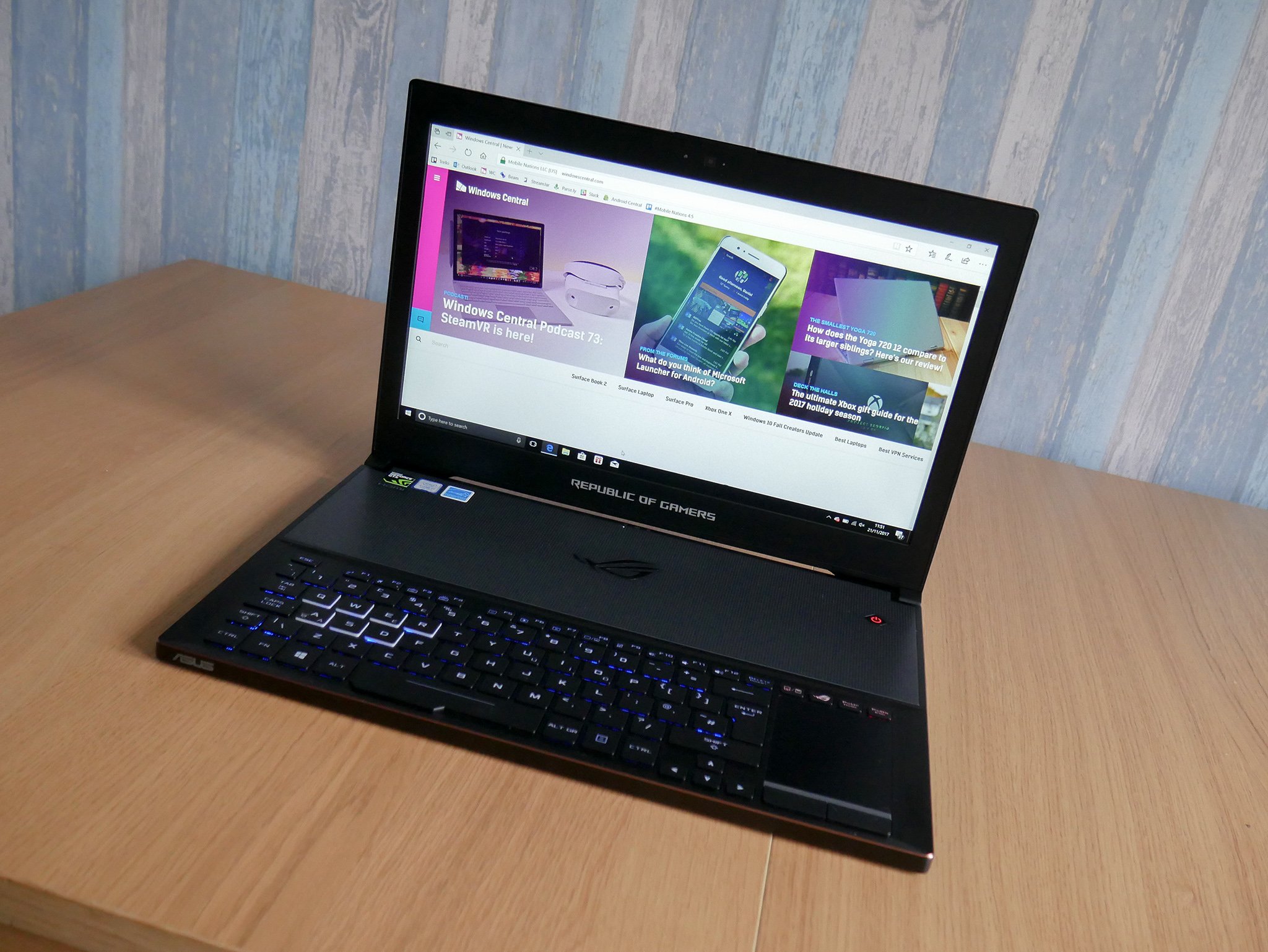
This laptop was used by NVIDIA as its poster child for its new MaxQ GPU technology, and with good reason. The unique design stands out, but it's also the very essence of what you'd be looking for in a high-performance gaming laptop. ASUS built a laptop for serious gaming, and so you miss out on 4K and a touch display, but instead, you get a 120Hz refresh rate and G-Sync for silky smooth, tear-free gaming.
It isn't perfect, and even though it's considerably cheaper at $2,699 than something like a Razer Blade Pro, there are compromises. The way the hinge raises the bottom of the laptop to aid cooling is ingenious but also makes it awkward to use on anything but a sturdy surface. Considering this is a portable laptop, you still won't be propping it on your lap.
Pros
- 120Hz G-Sync display is great for gaming.
- Incredible performance.
- Thin, innovative design.
- Great keyboard.
Cons:
- Difficult to use on a lap.
- The trackpad is on the small side.
- High price of entry.
Where the Zephyrus excels is in its performance. Cooling is excellent, restricting heat to an area you won't be touching, leaving the keyboard and trackpad nice and cool. It's also insanely fast, pushing games to take advantage of the display. It's not about how well you can play games hooked up to a monitor at 1440p or 4K; instead, it's about how good the experience is on the laptop.
This is a first look at the future of gaming laptops. It's thinner, lighter, and more powerful than ever before. The future still comes with a price, though, and you'll be spending at least $2,000 to get in on the action. The Zephyrus is still significantly cheaper than the top model Razer Blade Pro, though, while offering similar gaming performance. You don't get everything on this laptop, but as far as high-end gaming notebooks go, it's a remarkable piece of engineering.

Richard Devine is a Managing Editor at Windows Central with over a decade of experience. A former Project Manager and long-term tech addict, he joined Mobile Nations in 2011 and has been found on Android Central and iMore as well as Windows Central. Currently, you'll find him steering the site's coverage of all manner of PC hardware and reviews. Find him on Mastodon at mstdn.social/@richdevine
